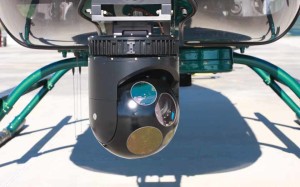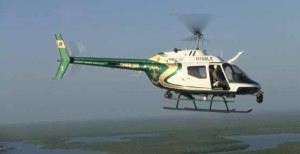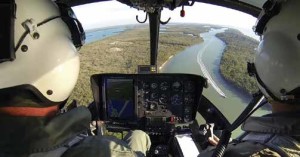Double Vision: CCSO’S 2 HELICOPTERS GET CAMERA UPGRADE

The Wescam MX-10 thermal imaging system houses two cameras. A color camera used primarily during the day can read an object the size of a license plate from more than 750 feet away. The second camera, an infrared thermal imager, can be used during the day and at night. Infrared technology permits the flight crew to see objects that may otherwise go undetected at night.
An aerial video shot from a Collier County Sheriff’s Office helicopter shows deputies making their way through a heavily wooded area in Golden Gate Estates.
The images of the deputies, viewed through the helicopter’s infrared imaging system, are bright white and surrounded by darkness as they step through overgrowth to reach a 47-year-old man with Down syndrome who went missing after wandering from his home in the 2600 block of Desoto Boulevard on July 14, 2014.
Even though they couldn’t see it, the deputies in the woods were headed toward a burst of white captured on the helicopter’s camera. Two deputies in the helicopter guided those on the ground to the burst of white – where they located Paul Charles Gunther.
It’s just one example of CCSO successfully using the enhanced thermal imaging cameras onboard the agency’s two helicopters to solve a case.

The new camera is lighter and smaller than the previous camera system. The small size and low weight allow the ball-shaped camera to be placed at the tip of the nose of the aircraft rather than under the belly, offering the crew an unobstructed view.
The Wescam MX-10 high-definition and infrared cameras were installed last year, marking the first major upgrade to Air1 and Air2 in about six years, said Lt. Mark Cherney, chief pilot for the CCSO Aviation Unit.
“The Wescam MX-10 cameras played a pivotal role in locating Mr. Gunther in that we will never know if he would have been able to make it safely back home on his own,” Lt. Cherney said.
Because the MX-10 employs a much higher quality focal plane array within the thermal camera, Lt. Cherney said, discerning Gunther from the background environment made detection much more likely than had the agency been using the previous cameras, which were older and outdated.
The cameras replaced two Wescam 12TS200 model cameras that were about six years old. One of the cameras suffered mechanical failure and the other was failing, said Cherney, noting the average lifespan for thermal imaging cameras is five years.

A screen grab from video taken from a high-definition camera onboard a Collier County Sheriff’s Office helicopter shows the moment three deputies found a 47-year-old man with Down syndrome who wandered away from his home in July 2014. Deputies in the sky guided deputies on the ground to the man’s location after the camera’s infrared thermal imaging system detected a heat signature in dense woods near the man’s residence in Golden Gate Estates. CCSO photo.
The new technology allows deputies in the sky to catch fleeing suspects and find lost persons quicker.
At 37 pounds and 14 inches tall, the MX-10 is lighter and smaller than the 12TS200. The small size and low weight allow the ball-shaped camera to be placed at the tip of the nose of the aircraft rather than under the belly, offering an unobstructed view. Prior to the MX-10 installation, pilots were required to maneuver the skid gear out of the picture during orbits around a target.
The camera system provides the helicopter crew with high-definition video as well as thermal imagery. It’s integrated into a mapping system that provides a 3-D overlay of the mapping data over the image for road information, and gives the option of adding local data from the agency’s geographic information system (GIS) for Collier County. It also has topographic mapping for search and rescue loaded into it.
The gyro-stabilized camera calculates the GPS coordinates of whatever it is looking at, and those coordinates are overlaid onto the map. So if crew members locate a person or object from the air, the camera will tell them the precise coordinates of what they have found.
The camera can also lock onto those coordinates so the pilot can maneuver the helicopter around the area for a better angle, but the camera will automatically remain aimed at the target. During a flight, the pilot controls the helicopter while a tactical flight officer operates the surveillance equipment.
The biggest difference is the infrared camera, Cherney said.

A Collier County Sheriff’s Office Aviation crew flies over Marco Island using a high-tech camera system. The recently added technology allow deputies in the sky to catch fleeing suspects and find lost persons quicker. Photo(s) by Cpl. Efrain Hernandez/CCSO
Even with slight temperature variations, infrared or thermal imaging technology permits the flight crew to see objects that may otherwise go undetected at night. This allows the flight crew to locate criminals who don’t want to be found or people who are lost and don’t know where they are.
The area where Gunther was ultimately located had been searched multiple times early on to no avail, indicating he had been mobile during the search, moving in and out of areas that had been previously cleared, said Lt. Cherney.
Some 24 hours into the search the flight crew decided to reinitiate the search from the beginning and completely re-searched the area that had been previously searched and cleared. The CCSO helicopter, using the Wescam MX-10 camera, located a heat signature and the crew directed three deputies on the ground to a location in the heavily wooded area.
“They located Mr. Gunther sitting with crossed legs in a very small remote clearing some 200 yards behind his residence in very dense woods,” Lt. Cherney said.
The CCSO Aviation Unit has been using infrared camera technology since 1996. The new cameras mark the fourth upgrade to the infrared technology.
The Aviation Unit is made up of four full-time pilots, including Cherney. All are trained to use the new technology.
CCSO helicopters fly law enforcement missions every day. The 1971 Bell OH-58 military surplus helicopters are available 24 hours a day, seven days a week, Cherney said.
Searches for missing persons, fleeing criminals and crime suppression patrols – saturating targeted areas with high-visibility patrols based on crime trend data – make up an estimated 80 percent of all aviation missions, Cherney said.
During the six years the helicopters had the 12TS200 cameras, the Aviation Unit located 123 missing people and assisted with 217 felony arrests and 100 misdemeanor arrests.
The Aviation Unit has located 16 missing people and assisted with 27 felony arrests since Jan. 15, 2014, when the MX-10s took flight.
Local law enforcement agencies greeted the new technology with enthusiasm.
Assistant Chief David Baer of the Marco Island Police Department said the department frequently taps CCSO’s Aviation Unit for assistance in finding missing children, seniors and boaters as well as fleeing suspects.
“I think the enhanced technology is fantastic,” said Assistant Chief Baer. “It enhances our abilities and will make Marco Island and all of Collier County a safer place.”

Leave a Reply
Want to join the discussion?Feel free to contribute!